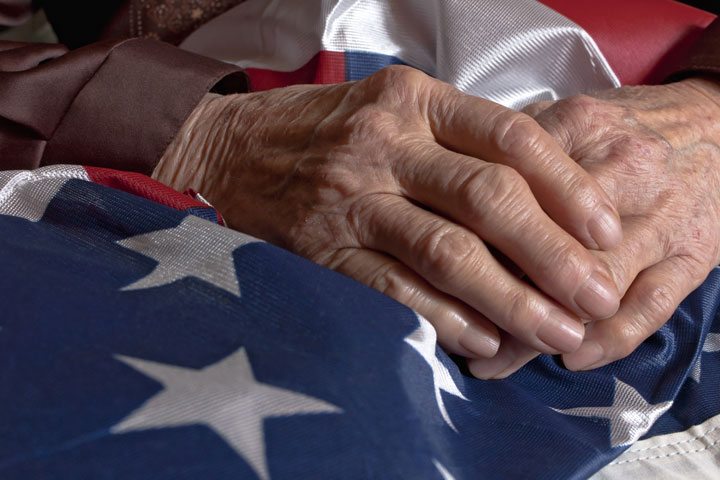“America’s commitment to its veterans are not just lines on a budget,” President Obama assured members at a recent Veterans of Foreign Wars convention. “They are bonds that are sacred — a sacred trust we’re honor bound to uphold.”
That assurance is extremely important for aging veterans who face the same challenges that confront seniors who are not veterans: health care, housing, and financial support, along with the need for help with personal care as health problems arise.
Like so many other seniors, veterans want to “age in place” — that is, they want to stay in their own homes as long as possible — but, like so many other seniors, they may need help with the tasks of daily living, such as getting in an out of bed, bathing, dressing, and preparing food. And like so many other seniors, veterans find that the costs of this extra care can be crippling.
But financial help is available for qualified aging veterans. Unfortunately, too many of them don’t know about this benefit. A Harris poll commissioned by A Place for Mom showed that 69 percent of 55-years-plus veterans and their families were not aware of the Veteran Administration’s Aid and Assistance benefit.
This tax-free benefit can provide eligible senior veterans with a spouse up to $2,727 per month to help pay for needed assistance with the chores of daily living. A single veteran (according to 2024 figures) can be paid up to $2,300 a month, a veteran’s surviving spouse up to $1,478 a month, and a veteran with a dependent child up to $2,727. Funded by the VA, the Aid and Attendance program deposits the monthly benefit directly into the bank accounts of veterans who qualify.
The benefit can be used whether the veteran or spouse needs the assistance with dressing, bathing, meal preparation and other tasks to be provided in a nursing home, a residential care home, assisted living, or their own home. Also, the benefit can be used to pay any person who provides the care, even a sibling or a spouse. This monthly cash payment is often referred to as a “special monthly pension”
Eligibility Criteria
A veteran or a surviving spouse may be eligible for the Aid and Attendance benefit if the veteran:
- Is at least 65 years of age;
- Received an honorable discharge from a branch of the United States Armed Forces;
- Served at least one day (but that day did not have to be served in combat) in World War I, World War II, the Korean War, the Vietnam War or the Persian Gulf War and had at least 90 days of continuous military service; and
- Can provide medical evidence that the veteran needs assistance performing tasks of daily living, though the help does not need to be available on a 24-hour basis. (The veteran’s personal physician can document this need.)
The veteran also must be able to demonstrate financial need for this benefit. To make this determination, the VA considers a veteran’s total assets or net worth, life expectancy, income (including any pensions or Social Security), and unreimbursed medical expenses. This combination of financial factors helps the VA determine if a veteran has enough assets and income to pay for care expenses.
Bedridden and disabled veterans also are eligible for financial benefits to help pay for their care, though criteria and eligibility are slightly different. (Details on all these benefits can be found at the Veteran Aid website.)
How to apply for Veterans Benefits
Applying for the Aid and Assistance benefit, indeed for any non-service related VA benefit, can be complicated and, given the backlogs and problems besetting the VA at present, processing the application may take some time. The average wait time for approval of benefits is about six months. Once approved, though, benefits are retroactive to the date of application.
You can apply for non-service related VA benefits in several ways:
- Apply in person at the nearest VA regional office.
- You can apply online at https://www.vba.va.gov/pubs/forms/vba-21-2680-are.pdf. (Have your doctor fill out the examination information section) If you are in an assisted living facility or nursing home, complete VA Form 21-0779.
- Fill out the completed form and send to your pension management center (PMC) in your state.
Better yet, and easier, you can contact a veteran’s service organization where volunteers can help you fill out the appropriate form. Check with https://www.va.gov/ogc/recognizedvsos.asp to find the nearest veterans service organization
In addition to the application, veterans will need a number of documents:
- Discharge or Separation Documents;
- VA form 21-22 if a service organization helps you or 21-22a if an individual is representing you;
- Form 21-4142 Authorization and Consent to Release Information to the Department of Veterans Affairs;
- A letter from your physician certifying need for assistance; and
- Documentation of medical expenses (VA form 21P-8416)
Surviving spouses applying for the benefit need a copy of the marriage certificate and death certificate. They also will need:
- Documentation of assets, such as bank statements and credit card statements.
- Verification of income from Social Security, IRAs, pensions and any other income sources.
- Insurance statements and medical bills not reimbursed by Medicare, Medicaid or other insurance.
- Voided check for checking account for Aid and Assistance benefit direct deposit.
(This article was reviewed in February 2024 since it originally published in August 2016.)
